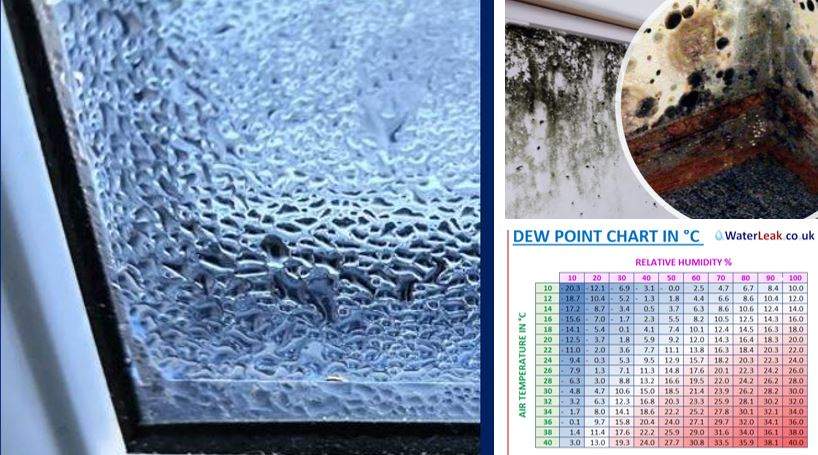Our Dew Point Calculator is one of the most popular tools on our site, so to compliment that, we have used it to create a dew point chart below. It helps you to quickly check the dew point in your property.
This dew point chart has a number of uses which we will go through later on this simple guide.
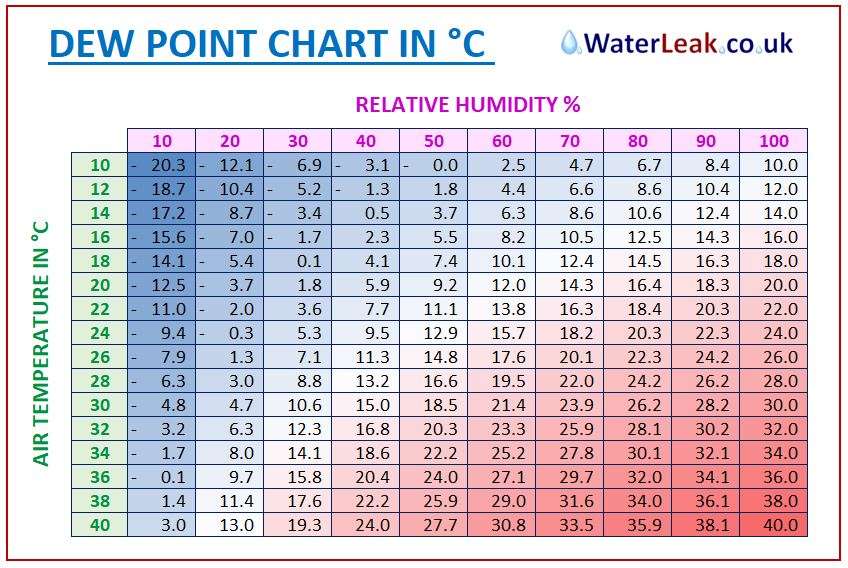
To use the dew point chart, simply look down the left-hand side (numbers in green) and pick your room temperature, then look across the top (numbers in green) and pick your relative humidity. Then cross tabulate to the place these intersect to work out what the dew point is in your room.
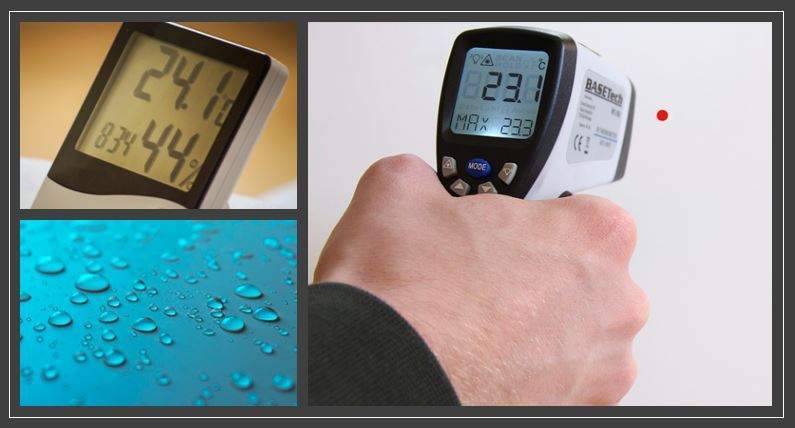
Dew Point Chart – Uses
A dew point chart can be used for a number of reasons, including to understand:
- How Humidity In Houses impacts things
- Mould On Walls, including Black Mould
- To see if a PIV Unit could be beneficial
- Check effectiveness of Bathroom Extractor Fans
- Likewise with Kitchen Extractor Fans
- Investigating Damp On Walls
- Which can lead to Mould On Walls
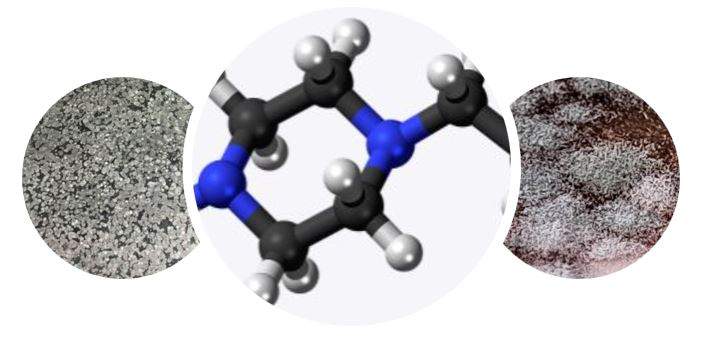
The list goes on but, as well as the above, they can also help you possibly see that the damp, condensation or mould you have on your walls may not be due to moisture contacting a surface at or below dew point. It might actually help you identify you have a water leak and would benefit from water leak detection services.
We can help you with many types of water leaks, including:
- Shower Leaking Through Ceiling
- Combi Boiler Leaks
- Underground Water Leaks
- Trace And Access Leak Detection
If you think you have a water leak, contact our friendly team today for help.
Dew Point Chart – Explained
The dew point chart above can really highlight how important relative humidity is in affecting the temperature needed for moisture in the air to settle as condensation on surfaces.
Take this one row from the dew point chart at 20 degrees room temperature:

As you can see, at 20 degrees (a fairly normal temperature in the UK), the dew point chart shows that variances in humidity in the property makes a huge difference on dew point.
At a fairly low relative humidity of 40% the dew point chart shows dew point is 5.9°C which is a very low temperature. However, at a higher relative humidity of 70% that temperature increases significantly to 14.3°C. Which, if you had a cold spot on your wall, or a cold window for example could easily cause condensation. This helps to explain why condensation and mould are often worse in winter.
On the subject of mould remember our guide to if it is Mould or Mold in the UK and regarding winter, our guide which explains the Beast from the East storms.
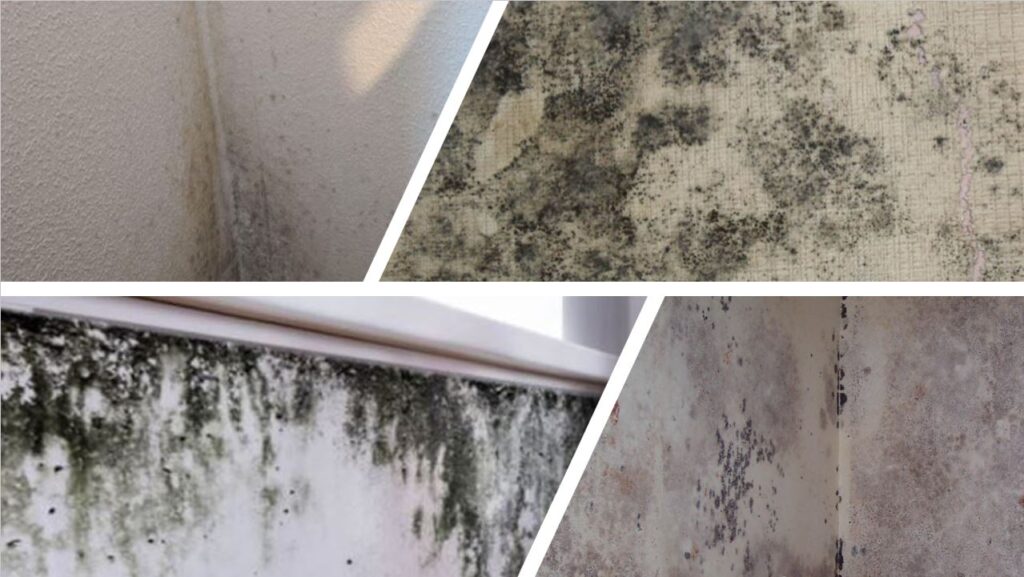
Dew Point Charts – Automatic with Meter
Hopefully, you can see that our dew point chart is simple and easy to use. But what other ways are there of working out dew point on your walls or ceilings?
Well there are two main ways most commonly used:
- Using a Moisture Meter
- Using a Laser Thermometer (certain models)
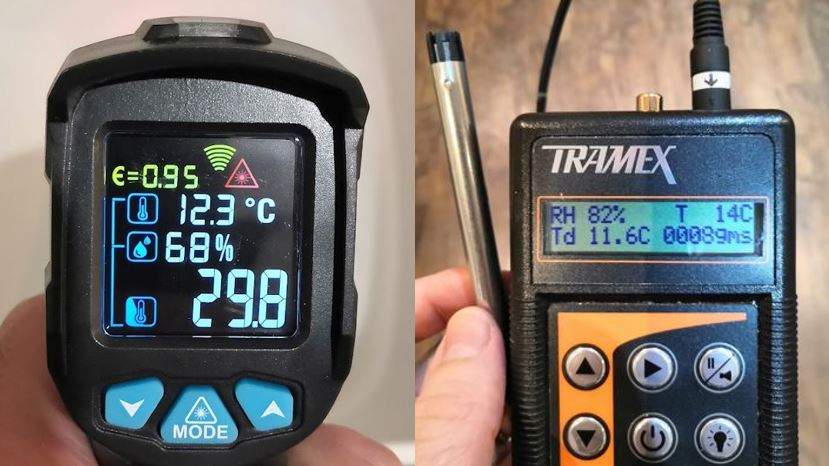
Both of these devices shown above have the ability to automatically measure dew point in a room, by taking measurements of both room temperature (dry bulb temperature) and relative humidity (RH).
Importantly, they will do this dynamically and refresh intermittently as readings subtly change. So if the user is moving from room to room, these two sets of numbers will vary and these devices will work that out constantly, rapidly and accurately.

Dew Point Sensors
In order for moisture meters and other devices to make calculations on dew point, like those displayed in our dew point chart, they use two sensors:
- A Hygrometer – to measure the relative humidity in the room
- A Thermometer – to measure the temperature
These two readings combined help to calculate the dew point needed to condense vapour or steam in the air into water, moving it from gas back to liquid state. Interestingly, you will see on the dew point chart how there are some negative temperatures shown – in some respects they are not as likely or relevant. At those temperatures the water would freeze (to a solid state).
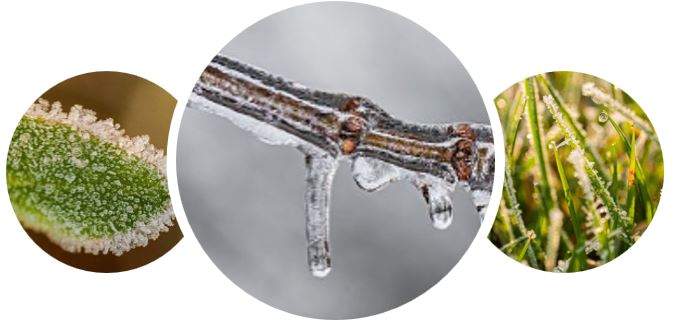
That said, we do see this happen in nature (in stages) as the water in the air settles as dew (like dew on grass), then temperatures drop further freezing the water, often overnight in winter months – especially December and January which are commonly the coldest.
Other Articles Relevant to Dew Point Charts:
- Silica Gel Packets
- How To Stop Condensation
- Water Test Kits and also Drinking Water Tests
- There’s a sister article on Water Testing Kits too
- Air Bricks Ventilation
- Desiccant Dehumidifier
We also have a recent water usage calculator which you may like to explore also our Bathroom Extractor Fan Calculation tool which is really useful.
Dew Point Charts (FAQs)
Which is worse humidity or dew point?
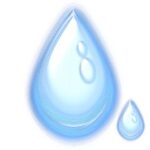
It’s not really right to ask which of humidity or dew point are worse as both play a part in the formation of condensation on surfaces, which can then lead to problems with damp and mould. However, if we were to pick one which has a bigger role, it would generally be humidity especially as that is (arguably) easier to deal with, especially through ventilation and extraction methods or, if needed by using dehumidifiers to lower the humidity in houses.
What does a 70 dew point mean?

Well lets start by saying that when saying ’70 dew point’ people are often confusing that with relative humidity readings. However, if we are to explain a 70 dew point (in Fahrenheit as 70 degrees C would be unlikely) it would mean that moisture in the air as vapour / steam would convert back from a gas state to a liquid state, usually as condensation if it were to come into contact with a surface which is at 70°F or lower, such as a colder window.
If you need help finding a water leak at your home get in touch with our team today. We offer these services to both domestic and commercial customers with commercial leak detection.
As experts in both water damage restoration and central heating leaks, we have you covered.
